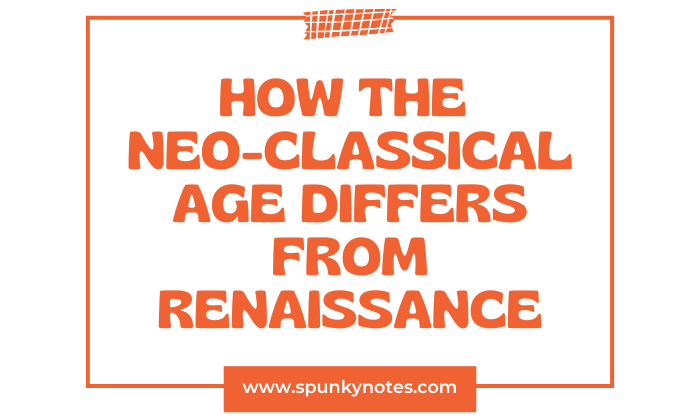

Estimated Reading Time: 6 min
Q. How does the Neo-Classical Age Differs from the Renaissance?
The Neo-Classical Age and the Renaissance both admired the classical works of ancient Greece and Rome. However, they differed in their approaches, values, and artistic goals. The Renaissance focused on humanism, creativity, and individual expression.
On the other hand, the Neo-Classical Age emphasized reason, order, and restraint. These differences shaped each era’s literature, art, and thought styles.
1. Humanism vs Reason and Logic
Renaissance
The Renaissance focused on humanism. This movement highlighted human potential, individual expression, and deep emotions. Writers and artists showed the human experience, often focusing on personal emotions.
William Shakespeare is one of the best examples of this focus. His plays, such as Hamlet and Othello, reflect emotions like love, jealousy, and ambition.
Shakespeare’s works highlight human emotions and individual experiences like others during the Renaissance. Characters in his works reflect on their choices and the consequences of their actions.
Similarly, Renaissance artists greatly emphasized the human form and its potential. Michelangelo’s sculpture “David” strongly represents human strength and beauty.
This focus on the human body as a subject reflects the Renaissance interest in humanism.
Neo-Classical Age
In contrast, the Enlightenment influenced the Neo-Classical Age, which began in the late 17th century and lasted through the 18th century. This intellectual movement emphasized reason and logic as the best ways to understand the world.
Writers in the Neo-Classical Age believed that literature should reflect order, balance, and universal truths, not personal emotions.
Alexander Pope’s “An Essay on Man” is a good example. Pope uses rational arguments in this poem to discuss humanity’s place in the universe. He focuses on balance and harmony in life. Unlike the emotional works of the Renaissance, Pope’s writing guides the reader through logic and reason.
2. Artistic Freedom vs Rules
Renaissance
During the Renaissance, artists and writers had artistic freedom. Strict rules did not bind them. Creativity, innovation, and breaking away from medieval traditions were highly valued.
Shakespeare often mixed genres in his plays, combining tragedy and comedy (tragicomedy). This blending of styles can be seen in “The Merchant of Venice” and “Twelfth Night”. The freedom to mix genres allowed Renaissance writers to experiment with new ways of storytelling.
Renaissance artists also experimented with new techniques. Leonardo da Vinci introduced methods such as perspective and chiaroscuro (the contrast of light and shadow).
These techniques brought depth and realism to his works, one example being “The Last Supper.” The Renaissance’s focus on naturalism and realism shifted from the more symbolic art of the medieval period.
Neo-Classical Age
In contrast, the Neo-Classical Age favoured strict rules and classical forms. Writers and artists believed that beauty and order could only be achieved by following guidelines.
Creativity was still important but had to fit within a formal structure. For instance, John Dryden’s “All for Love”, a retelling of the story of Antony and Cleopatra, follows the classical “three unities” of time, place, and action.
It reflects the Neo-Classical focus on structure and formality. Similarly, Alexander Pope’s “The Rape of the Lock” follows a highly structured style, using heroic couplets (rhymed pairs of iambic pentameter) to create order and balance.
The strict rules in art during the Neo-Classical Age were a reaction to the freedom of the Renaissance. Artists wanted to bring more order and balance to their work.
3. Imagination vs Restraint
Renaissance
Renaissance literature and art often focused on imagination and deep emotion. Shakespeare’s tragedies, like “Macbeth” and “King Lear”, deal with strong emotions such as ambition, betrayal, and madness.
Renaissance art often depicted emotional scenes as well. Titian’s painting “Bacchus and Ariadne” is a good example. The painting is filled with bright colours and emotional intensity, drawing from the mythical world.
Neo-Classical Age
In the Neo-Classical Age, there was more focus on restraint. Writers and thinkers believed that emotions should not overwhelm reason. They valued control and a sense of decorum in their works.
Samuel Johnson’s essays reflect the importance of balanced expression and moral guidance. Neo-Classical works aimed to maintain order and promote reasoned thought.
Jean Racine’s play Phèdre is a clear example. While the play explores human emotions, its structure is highly formal, reflecting the belief that reason should control emotions. The emphasis was on order and harmony, not unchecked passion.
4. Optimism vs Criticism of Society
Renaissance
The Renaissance had an essentially optimistic view of human potential. Thinkers believed that knowledge, virtue, and reason could help people reach great heights.
Thomas More’s “Utopia” is an excellent example of this belief. In this work, More imagines an ideal society based on reason and fairness. The Renaissance outlook saw humans as capable of greatness through knowledge and virtue.
Neo-Classical Age
In contrast, the Neo-Classical Age often took a more critical view of society. Satire became a popular genre during this period and was used to expose societal flaws and faults.
Jonathan Swift’s “Gulliver’s Travels” is a strong example of this shift. Swift satirizes human foolishness, vanity, and political corruption. He paints a darker picture of human nature.
Alexander Pope’s “The Dunciad” also critiques society. Pope exposes the moral and intellectual failures of the time, using his writing to question society’s cultural decline.
These satirical works reflect the Neo-Classical belief that society needed reason and morality to address its flaws.
5. Natural Beauty vs Controlled Aesthetics
Renaissance
Renaissance artists often depicted nature in its natural form. Albrecht Dürer, for example, painted detailed landscapes that highlighted the complexity and beauty of nature.
In Renaissance literature, nature was often presented as majestic and awe-inspiring. In Shakespeare’s works, nature plays a significant role, symbolizing harmony or chaos in the human world. This is especially clear in the storm scenes in King Lear.
Neo-Classical Age
The Neo-Classical Age viewed nature differently. Nature was seen as something that needed to be controlled and shaped by human reason. Artists and writers believed that nature should be depicted as orderly and balanced.
Pope’s “An Essay on Man” presents nature as part of a rational, ordered universe where everything has its proper place. Neo-Classical gardens, like those at Versailles, were designed with geometric shapes and symmetry.
These designs reflected the belief that humans could impose order and balance on the natural world.
Conclusion
Although both the Renaissance and the Neo-Classical Age admired classical antiquity, their approaches were very different. The Renaissance focused on humanism, individual expression, and creativity, resulting in works filled with deep emotion and personal experiences.
In contrast, the Neoclassical Age valued reason, order, and restraint, producing art and literature that followed strict rules. These differences in values and approaches shaped these two important historical periods’ distinct artistic and intellectual cultures.


